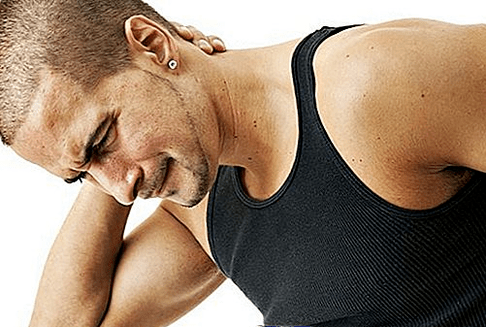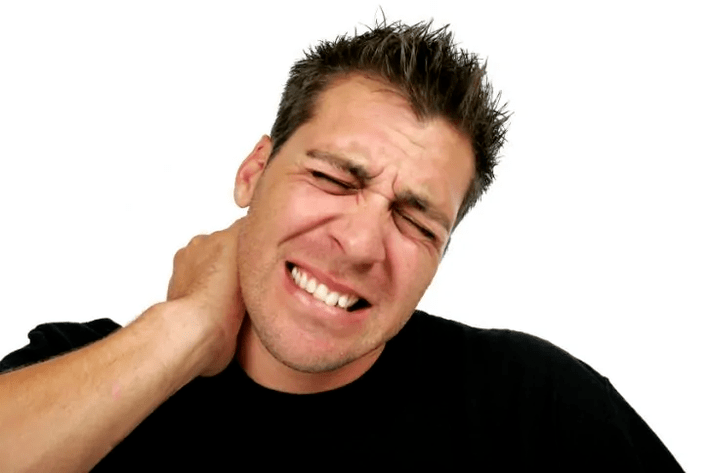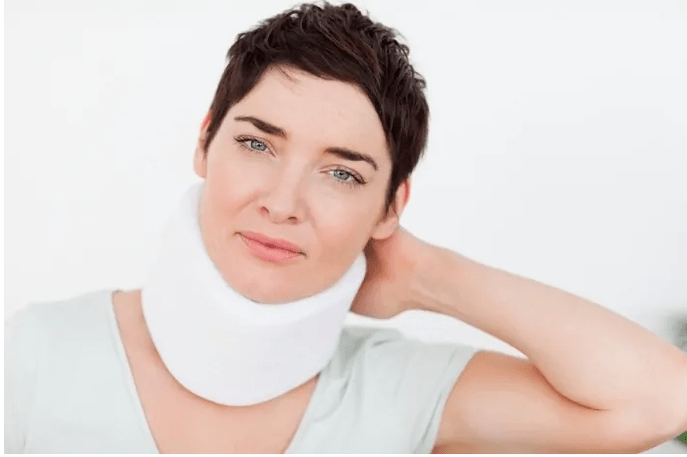Osteochondrosis is most frequently observed in the cervical spine, which is due to the anatomical features of the structures of this department. First, the cervical vertebrae are very firm to each other. Secondly, the muscle frame of the neck is poorly developed. For these reasons, the cervical vertebrae and the compression of nerve roots, blood vessels are so light that the lower cervical vertebrae are affected more often than the upper.

Cimptoms of cervical osteochondrosis
The clinical symptoms of a neck osteochondrosis are extremely diverse. Many people do not even propose all types of symptoms (pain in their hands, dizziness, etc. ) can be associated with the pathology of the neck. In general, all symptoms in cervical osteochondrosis can be taken into account within three syndromes:
- Compression syndromes;
- Irritative reflex syndromes;
- Vail arteries syndrome.
Compression crust syndromes
Against the background of cervical osteochondrosis, intervertebral hernia and osteophytes can be formed. These structures compress the nerve roots, which leads to the occurrence of radiculitis symptoms. The compression of each spine is associated with specific reflex, engine and sensitive diseases:
- When compressing the spine of C1, pain and impairment of sensitivity (acceptance of sensitivity, deafness, tingling, skin feeling, goosebumps) occurs in the parietal area;
- When compressing the spine of C2, pain and a change in sensitivity in the parietal and consuming area of the head develop;
- When compressing the spine of C3, pain and a change in sensitivity in the neck are determined. In addition, a person can be disturbed by the feeling of swelling of the tongue on the one hand, difficulty movements of language and language impairment.
- When compressing the S4 spine, pain and a change in sensitivity are determined in the collarbone. Icote, dysphonia can occur. Since fibers of the diaphragm in the spine with compression of the spine, breathing, pain can occur, pain in the heart can occur.
- When compressing the spine of C5, pain in the shoulder develops and a change in skin sensitivity on the outer surface of the shoulder.
- When compressing the C6 span, the pain spreads from the neck to the shoulder blade and the outer surface of the shoulder, the forearm and the thumb of the brush. A violation of skin sensitivity in this area has been determined. The two -leaf muscles is exaggerated, the reflex is reduced.
- When compressing the C7 spine, the pain spreads out of the throat under the shoulder blade, to the outer surface of the shoulder, the forearm and the II -II fingers of the hand. A violation of skin sensitivity in this area has been determined. The three -member muscle is exaggerated, the reflex is reduced.
- When compressing the spine of C8, the pain spreads out of the neck on the hand to the little finger. The skin sensitivity in this area is disturbed. Hypotrophy and a decrease in the reflex from the three muscles led with the heads occur.
Acute pain and its strengthening when moving the head are characteristic of the radicular syndrome.
Stimulus reflex syndromes
The early stages of osteochondrosis are characterized by the appearance of reflex syndromes. With cervical osteochondrosis, the following options for reflex syndromes can occur:
- Cervicalgia is an intense painful pain in the neck that is expressed as far as possible after waking up in the morning, as well as when the head, cough and even laughter turn.
- Cervicobrachialgia - pain concentrates on the neck and neck.
- Cervicobrachialgia - pain in the neck, shoulder and forearm.
Cervicobrachalia can occur with muscle tonic, vegetative-vascular and neurodystrophic manifestations. Muscle -Tonic syndromes are the result of a reflex muscle cramp. The following muscle tonic syndromes are differentiated:
- Syndrome of the lower sloping muscle - manifests itself through constant painful pain in the neck and in the back of the head on one side, which is significantly intensified during the head wind;
- Schaubel-reflecting syndrome manifesto even with painful pain in the neck and the upper corner of the shoulder blade and in the shoulder or even in the side surface of the breast. A characteristic feature is an increase in pain during the pronunciation of the brush open through the lower back.
The neurodystrophic syndromes include shoulder-packed periarthrosis, shoulder-shoulder syndrome of epicondylels. Shoulder -Shoulder -periarthrosis -characterized by pain in the shoulder joint, increases during the movements of the shoulder or increases the hand. The pain can radiate to the arm, neck. The skin in the shoulder joint is swollen. For the syndrome of the shoulder, the presence of a spatular periardroz in a combination with vegetative-vascular, trophic changes in the wrist and brush is characteristic. The skin of the brush becomes edematous, its colors changes, the local temperature increases. Epicondyles shoulder is a neurodystrop change of the shoulder rod instead of the attachment of many muscles. It manifests itself through painful, constant pain in the area of the rod and increases in the implementation of abrupt movements on the elbow or the brush.

Vail arteries syndrome
The vertebral artery takes place in the channel, which is formed by the processes of the cervical vertebrae. The ship provides the blood supply to many brain structures. The narrowing of the vessel is possible due to its reflex cramp and its mechanical compression. When the vessel narrowed, the syndrome of the vertebral artery is formed, which are characterized by the following symptoms:
- Erran: painful, constant headache more often one -sided, noticeably intensified with head movements. The pain spreads from the back of the forehead.
- Pain of the scalp, determined with slight touch, even if you comb hair.
- Koblleovestilarnyi violations: they manifest themselves through dizziness, tinnitus (ringing in the ears), a decrease in a slight extent and a violation of the balance.
- Visual disorders: darkening, flickering fly in front of my eyes.
- Neurasthenic syndrome: irritability, emotional instability, sleep disorder.
- Vegetative symptoms: heat, chills, hands cooling.
- Fluctuations in blood pressure.
- With the compression of the vertebral artery caused by a sharp turn of the head, a person can lose consciousness. This option is also possible: one person falls as prepared, but at the same time it is aware. Such a violation is called drop attacks.
Treatment of cervical osteochondrosis
It is very difficult to fight osteochondrosis in an advanced form. Different medicines are used to eliminate the symptoms of the disease. Therapeutic gymnastics and physiotherapy massage play a no less important role. In some cases, wearing a special collar is very useful. People's funds will help complement the treatment.
Wear a cervix collar
Wearing a collar helps to relieve the muscle tension from the neck and gives the spine the correct position, which eliminates the compression of the vertebral artery and nerve roots. The neck collar are stiff (Shantsa collar) and inflatable. Shanz collar is a dense frame that is attached to the neck. He takes on the whole severity of his head and relaxes the tense muscles of the neck. Flatible collar are a device that needs to be placed on the neck and then with the help of a connected pear pump air. The inflated collar pulls the spine. The collar is not worn all day, but a few hours a day. On average, the length of wearing the device is one month. Please note: The need to use the collar is determined by the doctor. Under no circumstances use it without a doctor on your own. In some cases, the collar can hinder the vessels and nerves, which can have serious consequences.
Exercises for the osteochondrosis of the cervix

Therapeutic gymnastics is recommended for all patients with osteochondrosis in the absence of contraindications. The implementation of physical exercises in the event of deterioration in the disease is contraindicated. Therapeutic gymnastics can be carried out after the pain was taken. By regularly carrying out exercises, you can strengthen the muscle frame and reduce the load of the intervertebral discs. Regular physical activity contributes to improving blood supply in the neck and as a result of the normalization of the metabolic processes in the intervertebral discs. An approximate series of exercises for cervical osteochondrosis:
- Sit on a chair. Turn your head to the right and left.
- Tilt your head down and touch the seizure of the chest.
- Pull your neck back and draw a chin.
- Place your palm on your forehead and press it while it is important to tilt your head forward and oppose yourself.
- The palm of your hand has to be applied alternately to the temple and absolutely in the previous exercise in order to set the resistance to the movement of the head with one hand.
- Lift your shoulders as far as possible and count on ten. Then lower your shoulders and relax. Make the same manipulation after ten seconds.
All exercises have to be repeated ten times.



























